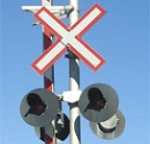Driving near railway crossings
Know what to watch out for at railway crossings and when you must stop.
Warning signs and markings

In Ontario, all railway crossings on public roads are clearly marked with signs. There may also be:
- a large “X” on the pavement
- flashing signal lights
- gates or barriers
On private roads, the crossings may:
- use different types of signs such as stop signs
- not be marked at all
Do not cross unmarked or unauthorized railway crossings. Only ones that are properly marked and meant for crossing.
Crossing railway tracks
As you come to a railway crossing, slow down, listen and look both ways before crossing the tracks. You should be certain that you can clear the tracks completely before crossing.
When a train is coming
Never race a train to the crossing. Follow these steps to cross safely:
- Slow down.
- Stop at least five metres from the nearest rail or gate.
- If there are signals, wait until they stop flashing before you start driving. If the crossing has a barrier, wait until it fully rises.
- Make sure there is no second train approaching in either direction after the first.
- Only cross the track when you're sure the train has passed.
It is illegal and dangerous to drive around, under or through a railway barrier or gate while it is down, being lowered or being raised.
Safety tips
- Be ready to stop behind buses. Most buses are required to stop at railway crossings that don't have gates, barriers or lights. School buses must stop at all railway crossings.
- If traffic is heavy, make sure you have enough space for your entire vehicle on the other side of the tracks before proceeding across.
- Avoid shifting gears on railway tracks because your vehicle could stall and put you or others in danger.
- Never stop on the tracks.
Commercial drivers
- Know the length of your vehicle and load overhang to make sure there is enough space to safely cross the tracks.
- Avoid crossings where low-slung units can get stuck on raised crossings.
Cyclists
- Always cross at right angles to the rails.
- Obey the same railway crossing laws as drivers.
Read more about how to stop at a railway crossing in the Official Driver’s Handbook.
If you get stuck on a crossing
- Get out of the vehicle immediately.
- Quickly move away from the train track to a safe location. You need to be at least 30 metres away to avoid being struck by flying debris if a train hits the vehicle. It takes up to two kilometres for a train to stop even using full emergency braking.
- Contact the police. They will help you remove the vehicle from the tracks.
Penalties
If you fail to stop at a railway crossing, you can face:
- $110 fine ($150 in community safety zones)
- 3 demerit points